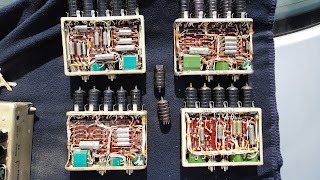Helicopter Charlie came complete with her own "Black Box."
seen here sitting on the trunk-deck of my Honda.
The Army nomenclature for this was "S.A.S' for stability augmentation system.
The Navy/Marines called it "A.S.E." for auto-stabilization equipment.
It was basically an auto pilot; this electronic device would help the helicopter be more stable and dampen out much of the naturally instability inherent in helicopters. It made the H-34 a lot easier to fly.
The big box lived up on the transmission deck, beside the rotor brake. It had MILES of wiring going to/from it to control the helicopter in three axes, pitch, roll and heading.
Only the Navy version had altitude control, used for flying out over endless tracts of ocean
on anti-submarine missions. The Navy pilots would fly out 100 miles from the aircraft carrier, then lower a sonar listening device deep into the water to listen for submarines. So that the pilots would not have to manually hold a hover for hours, they used a doppler system tied into this box; once they got on station about 50 feet above the water, the helicopter would do all the work of hovering itself for hours. How boring this must have been. Until they heard a sub, then I bet it got very exciting!
They called this, "Dipping their balls."
In this frontal view you can see four ports for attaching cables, and at least nine adjustment screws for tweaking settings in the electronic setting inside.
Here the cover has been taken off and you can see what is inside.
It has rows of vacuum tubes on either side. and circuits below the tubes.
Looking down into the center from above.
(More about the small empty space later.)
This is the bottom of the black box. Wires and circuits abound.
Each bank of tubes is removable from the side racks, and has its own set of wiring under. It was Murphy-proof in that each rack of tubes will fit only on one position around the central box.
The whole thing weighed about 20 pounds. I'll bet that today it is replaced by one small mother board,
or perhaps even one single micro chip!
about that empty central space in the box:
In the summer of 1969, after getting out of the service, I worked in Alaska for a company (ERA)
that flew the predecessor to the H-34, the H-19, or S-55.
I was sent to Amchitka Island, nearly at the end of the Aleutian chain on contract for Pan American World Services to work on the underground atomic testing.. On a clear day we could almost see Russia from there. I flew biologists all over the Okinawa-sized island to study the wildlife, both before and after the underground explosion of the bomb called Millhouse, after President Nixon, perhaps.
(There is much more to this story, but I will keep focused on the black box for now.)
I had some minor illness while on Amchitka, so I went to our paramedic. As we talked, he asked me,
"What makes them helicopter work, anyway?" I replied,
"It's the black boxes You've heard of black boxes, right?."
"Well yes," he said, "So what's in them black boxes?" I gave it some thought, then I told him.
"As a helicopter pilot, I have always wondered that myself". I confided to him, "One night, just before I got out of the service, I found myself alone on duty in the squadron avionic repair spaces. I looked around; no one was there. I found myself a screw driver and I opened one of them black boxes just to see what was in it. I had to know."
"Do you have any idea what I found in there?" I asked him, in a hushed, conspirational tone as I furtively glanced around to see if anybody might be listening.
By now he was spell-bound and thought I was going to let him in on some great military secret.
Then I said, "Well when I opened up that black box,
I found an itty-bitty witch doctor sticking pins into birds; that is what makes helicopters fly."
(It's the itty-bitty witch doctor who lives inside the center of the black box.)
Incidentally, after the atomic bomb testing, they had to re-name the island.
It is now called Am-ka because they blew the "chit" out of it.






